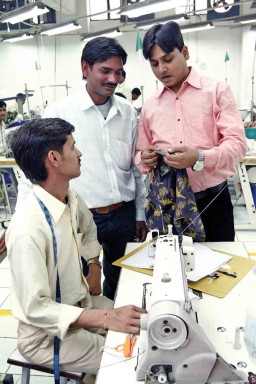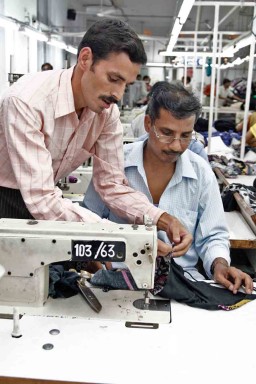
On a practical level, the day-to-day control and management of the direct workforce is the responsibility of production managers and supervisors and it is the performance of these people that will determine how well a factory performs. This is true in every industry and a fact known to each of the senior managers. But due to their overburdened schedules and lack of motivation, majority of these managers are not able to devote sufficient time, energy to prove their competence and capability.
The major factor in the underperformance of a factory is ineffective leadership at the middle- and junior-level managers and supervisors. Paul Collyer, a garment industry expert with over 37 years of international exposure in production management, emphasises on effective leadership recounting his firsthand experience with the industry.
Supervisors are the first tier of management in a clothing factory and hence ineffective management by them leads to beginning of underperformance of the factory.
The often-quoted five needs of the managers discussed below are considered as the first steps to effective leadership. Companies also have to ensure that their production management teams perform to required standards under high pressure and in dynamic working environment.
1. Agree with me the results I am expected to achieve
How many managers and supervisors know exactly what they are expected to do and to what standards (expressed in measurable terms)? The most commonly used method of agreeing (not imposing) targets and work standards is through a job specification or description with measurable Key Performance Indicators (KPIs). They do not have to be complicated or in too much detail; indeed the KISS approach has much to merit it. (Keep It Simple, Stupid). An example of a job specification for a line supervisor is shown below. It should be taken as a guide as the role varies in every organization.
Job specification
[bleft]Senior managers should determine the exact extent of the responsibilities and authority of juniors including supervisors and these will be contained in the job specifications[/bleft]
Line supervisor reporting to production manager. Summary of role To manage people, materials and equipment on the line and to ensure all quality, output, delivery and cost targets are achieved.
Key Responsibilities
- Plan new styles in conjunction with production manager and IE department.
- Manage line on daily basis.
- Manage operators including motivation and discipline.
- Ensure that the finished goods quantities sent to packing are correct.
- Manage quality to ensure customer requirements are achieved.
- Meet KPIs.
- Coordinate with higher authority and other departments as necessary.
- Control housekeeping and machine cleanliness on section.
- Identify operator training needs and refer to production manager.
- Maintain needle replacement policy.

Key Actions
- Key actions can be categorized into monthly, weekly, daily and during style change. For example: analyse previous month’s quality problems and initiate corrective action plan. Maintain skills matrix weekly and return surplus accessories to warehouse weekly. Daily actions to include:
- Attend daily production meeting.
- Review attendance/absence, formulate daily plans and liaise with production manager for additional resources as required.
- Monitor output and WIP levels at designated 2-hourly intervals, make decisions and problem solve as necessary.
- Target/objective set for operators in section (target sheets).
- Review feedback from QC department at designated intervals and take appropriate corrective action.
- Check output of each operator for quality (minimum of 4 times per day). Problem solve as necessary.
- Monitor order status to ensure delivery dates are met.
- Perform any additional duties as requested by management.
- Identify low performing operators and report to manager.
Key actions during style change would be
- Plan people, machinery, materials, layout and equipment three days prior to style going onto line. Prepare initial balance in conjunction with IE department.
- Report materials usage from first batch.
- Report operator training needs to production manager.
Key Performance Indicators
- Weekly calculate delivery output to packing at designated time and dates (100%).
- Calculate weekly section average operator performance target (90%), line efficiency (85%) and operator off standard targets (3%).
- Calculate weekly percentage of reworks against output (maximum 5%).
- Biannually measure stock.
[bleft]A garment factory manager will only be as good as his supervisors and the supervisors will only be as good as the manager allows them to be[/bleft]
The KPIs used above are simple and should be measured, as part of the production management function by any organized factory. A more detailed explanation of 7 measures for the production unit was published in The Production Manager, Seven Measures and Information Systems, StitchWorld, March-2007. They can be used for the supervisor in charge of one line or the production manager responsible for a number of sections.
2. Give me an opportunity to perform
Senior managers should determine the exact extent of the responsibilities and authority of juniors including supervisors and these will be contained in the job specifications. Unfortunately it is a common behavioural trait in humans to retain as much power and influence as possible, not to delegate and restrict subordinates to a role in which they are not a potential threat. A manager responsible for lines containing 100 workers cannot possibly know what they are doing or not doing in sufficient detail to influence their performance. It is crucial that those lower down the command chain and who work closer to the operators are given the opportunity to manage people.
3. Let me know how I am doing
With measurable performance standards established, it is a simple task to give feedback on a daily, weekly and ongoing basis as part of the management system including daily production meetings. Additionally it is necessary to give an overall view of how individuals are progressing and contributing to the business. This should of course be part of the performance management system notably during appraisals.
It should be noted that it is not possible to give factual feedback or appraise the individual’s efforts without first defining their role in job specifications and standards of performance in KPIs. Any attempt to do otherwise will inevitably result in dissatisfaction or conflict as reviews based no measurable basis, i.e. “That manager does not like me” or “She is the manager’s favourite”.
4. Give me guidance and training where I need it
From the details contained in the job specification, it is feasible to draw up a list of key skills and knowledge needed to perform the role. During the performance appraisal, individuals should not only receive feedback but should also be assessed against the list, with emphasis on the skills necessary to perform those tasks in which they have underperformed. A training and development plan can be formulated and this becomes the key outcome that should form a major part of any performance management system. All managers should be competent in guiding and mentoring subordinates and these skills constitute a fundamental role of the manager as a leader.
5. Reward me according to my contribution
Whereas Maslow gives us a number of levels of motivation, the need for appreciation and self improvement can be covered in a well conducted appraisal and we shall consider here the key motivation tool: Money!
It can be argued that production managers and supervisors work at their hardest when the lines are performing the poorest, i.e. when they are striving to overcome difficulties. This should not however be a deterrent from implementing incentives and neither should the other often quoted reason: quality will suffer!
Again if the areas of responsibility for individuals are measured against KPIs, it is possible to give a bonus for achievement that is clear and easy to understand. A well constructed scheme will allow for drops in performance due to varying frequencies of style change.
Any bonuses or incentive payments will be based around performance KPIs, most notably efficiency. To give an incentive based solely upon reaching a production target of number of garments is very simple but can be counterproductive as it may create the desire to hoard operators to ensure that output levels are met without any concern for cost-effectiveness.
Moreover, an incentive scheme that puts total emphasis on output and efficiency without concern for quality will not fit into the remit of any part of the garment industry. Quality problems will of course reduce the effectiveness of any production unit and most supervisors and managers should tackle them out of a sense of duty and not only for the reason of ensuring meeting production targets. However it has to be acknowledged that many may still be tempted to “chase the money” and to take a chance on quality. There are both direct and indirect approaches to tackle this problem. Any appraisal system will review their performances against quality KPIs as well as senior managers regularly monitoring quality performances. However a more direct measure is to make payment of performance bonuses conditional upon staying within quality KPIs! Alternatively if that is seen as too severe an additional payment can be made for achieving both production and quality KPIs with the sanction of a punitive reduction in bonus if quality levels are not achieved.
It is, of course, essential in all incentive schemes that criteria for reward are simple and transparent and the rules are clearly set out. Complications and uncertainty will inevitably lead to mistrust as will any reward that is awarded at the “manager’s discretion”.
Many companies also operate salary bands for specific roles and individuals work through the band usually on an annual review basis depending upon performance.
Unfortunately many others also allow progress through bands depending upon length of service. In this modern age, it is necessary to base rewards on how well someone does the job and not on how long they have been doing it! If senior management want to reward loyalty then that should be a separate part of the salary scheme. It is essential that any award for performance is based upon the measurable outcomes and such awards should be scheduled to be as far away from the appraisal as possible. Where it is possible for the individual to think that appraisal outcome equals salary change, then the effectiveness of the appraisal will be compromised.
Conclusion
“A garment factory manager will only be as good as his supervisors and the supervisors will only be as good as the manager allows them to be!”
To be profitable and productive, a garment manufacturing unit needs an integrated management and supervisory team working to specified standards. This can be achieved through the use of effective performance management, production management and training and development systems. Many companies will say they have all of these in place but as with all business practices regular audit and review is necessary to avoid “slippage”.
Whereas ongoing reviews and improvement programmes of manufacturing systems and methods including equipment are essential if companies are to remain competitive, the fundamental role of the manager and supervisor as a leader should not be ignored; they are the crucial link in making the best use of the companies’ greatest asset – Its people.






